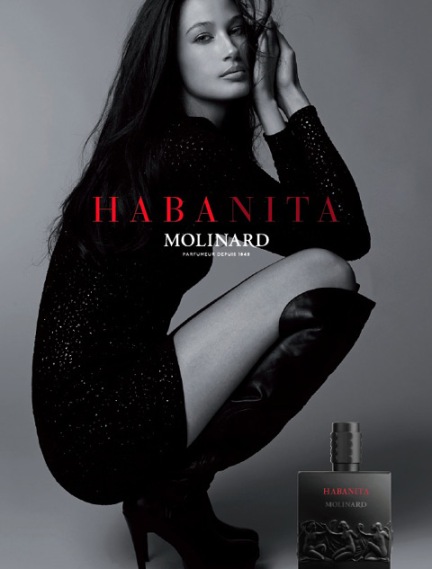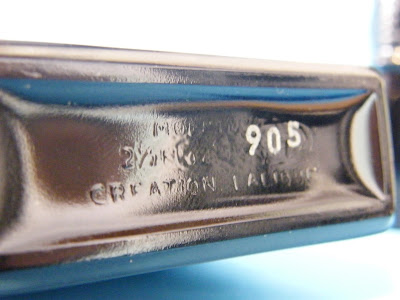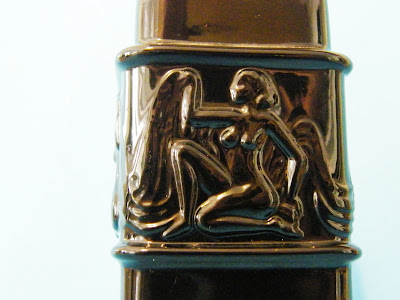"Imagine to walk in an oriental spice bazaar, with a bunch of exotic flowers in your hands, and a leather factory on your left, and a tobacco manufacture on your right....and suddenly a cloud of talc powder comes down to surround you. This is Habanita."
This is a good description of one of the most legendary perfumes in history: Habanita de Molinard.
You will find spices, tobacco, leather, flowers, talc powder, blended all together. It seems Habanita has been fulfilled with almost every ingredient used in perfumery. Actually, according Molinard, Habanita contains more than 600 (!) ingredients.
Apparently, according to tradition, Habanita could stay in the group of those perfumes called "feminine but masculine": Tabac Blond de Caron, Bandit de Robert Piguet, Cabochard by Grès, Jolie Madame by Balmain. But, in my opinion, Habanita is more similar to another lost gem from the past: Tabu by Dana. However, if you know and appreciate any of these perfumes, you will feel comfortable with Habanita. In addition, sporting a strong tobacco/spice/leather core, Habanita could fit perfectly for men, too. Be careful, Habanita stands on its own feet and it's immediately recognizable. You can't be wrong: when you smell it, you immediately say: this is Habanita.
As usual, you can read tons of review about Habanita on the web, so we'll leave floor to a few of highly estimated reviewers (listed at the end of this article).
Hanbanita is in production since 1921 and was probably reformulated several times. Good ol' friend Gianni Ambrosio, the now-retired retailer from Milan, generously borrowed me a couple of vintage EdT bottles from his collection, plus the modern EdP version on sale today, for a comparative review. Laura added a small sample of her precious older vintage. So I was able to perform a really comprehensive review.
How does vintage Habanita de Molinard perform in front of the modern one? Firstly, we have to learn something about different versions, bottles and packages used during last decades.
So, let's go and see!
Since 1980 Habanita changed four boxes and bottles, and each time *apparently* underwent a reformulation (we are considering the scent produced since the 1980s and tested here, but there are other versions, not tested in this review).
Briefly:
1) Transparent bottle with "syllables" on the front (i.e. HA/ BA/ NI/ TA) (produced from 1980 until 1988)
2) Lalique-type "squared" bottle (produced from 1988 until 2005)
3) Lalique-type "tall" or "Anniversary" bottle (produced from 2005 until 2012)
4) Modern bottle (EdP only, in production since 2012)
Pictures:
1) Transparent bottle with "syllables" on the front
(i.e. HA/ BA/ NI/ TA) (from 1980 until 1988)
(i.e. HA/ BA/ NI/ TA) (from 1980 until 1988)
 |
| From 1980 until 1988: transparent bottle with "syllables" (HA-BA-NI-TA) |
 |
| EdT box and bottle (1980-1988) |
 |
| Year 1983 advertisement |
--------------------------------------
2) Lalique-type "squared" bottle
(from 1988 until 2005)
 |
| Year 1988 advertisement |
 |
| Year 1991 advertisement |
| Lalique-type "squared" black bottle. |
Without barcode: before 1990
Barcode without Greendot = between 1990 and 1992
With Barcode and Greendot: after 1992.
---------------------------------------
---------------------------------------
---------------------------------------
3) Lalique-type "tall" or "Anniversary" bottle
(from 2005 until 2012)
(from 2005 until 2012)

 |
| From 2006 until 2012. Lalique-type "Tall"/"Anniversary" black bottle |
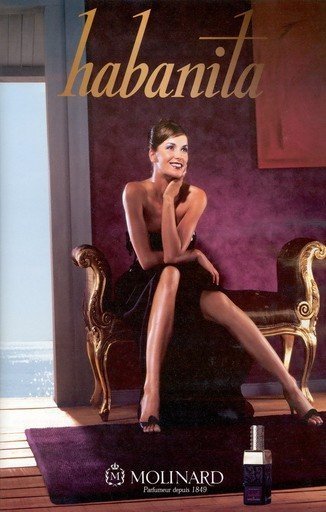 |
| Year 2006 ad |
| (When you read the long list of ingredients on the box it means "produced after 2005") |
-------------------------------------
-------------------------------------
-------------------------------------
4) Modern bottle
(since 2012)
(since 2012)
Modern (EdP only) bottle, since year 2012
Materials and Methods All tests were made side-by-side, inside a clean, no-windows, odorless room, at the same temperature: 20°C / 70 F. Due to tiny amount, the "syllable"-bottle sample (the older one) was tested on paper and on skin only. All other three versions were tested on paper, on skin, and sprayed on clothes. Three samples are EdTs, the fourth (the modern one) is an EdP.
First thing to say: there is not a version that is exactly identical to others. All four versions appeared distinct and somewhat different. This could mean a reformulation actually happened with every "edition" launched during decades. But, at the same time, Habanita is immediately recognizable in all four version. It's still Habanita, no doubt. It's the same DNA. A pleasant news is that there isn't any version watered-down or weakened. All four versions are very strong on paper and on skin. There are great sillages and great longevities: on your skin, Habanita stay for at least 12 hours; on paper, you can easily smell it after 4-5 days. Even more, if sprayed on your clothes. This is a good news since you can suspect - as usually happens- that modern versions are weaker than older ones. In this case, this isn't true. Even the recent formulation (year 2012, labelled as "EdP") is very strong, and "on par" with vintage ones. Differences are rather in formulas. Briefly: 1) The older bottle (the "HA/ BA/ NI/ TA" one, 1980-1988) smells almost as pure leather + tobacco + vanilla + lot of powder. Very "rich" and "decadent", it reminds ladies smoking in Jazz clubs during 1930-1940s..... A bit dated, anyway, I like such perfumes very much. 2) The Lalique-type "squared" bottle (1988-2005) appear to be more modern, with more balanced ingredients. There isn't any note prevailing over others, the blend is equilibrate. Very suitable for men, actually, it is an unisex scent. Perfect mixture between "female" and "male" aspects. This version is probably preferred by those seeking for an "ideal" blend. 3) The Lalique Type "tall"/"Anniversary" bottle (2005-2012) is similar to the previous one, but notes are more pronounced. While the previous version aims to balance and soften all notes, this one tends to "unbalance". Vanilla, leather and powder emerge fiercely from the bunch. This version is probably preferred by those wanting a stronger, more decise, and tougher scent. 4) The modern EdP bottle (since 2012) is probably the more feminine of all versions. A strong floral note appear, and accompanies other notes, during the entire evolution. The best choice if you want Habanita as a proper "female scent". --------------------- FINAL WORD Put it simply: Habanita was reformulated in all its editions. The most pleasant fact however is that Habanita has not been ruined by any reformulation. All versions are very strong with great longevity and sillage, and retain the Habanita inner core. However, all four versions tested are not identical to each other. For example, the modern version (since 2012), thanks to its pronounced floral vibe, can be considered "a female scent" much more than previous ones. On the contrary, the two Lalique-type bottle are pretty "unisex" and fits for men, too. And the first version tested ("HA/ BA/ NI/ TA") pleasantly smells even as an "old auntie" perfume. You can't ask "what's the best?", since they all appear as "variations on a theme". So, the last choice is up to you. similar "side-by-side comparison" articles: - Mitsouko by Guerlain: yesterday and today (2013) - Opium by YSL : 11- bottles comparison test (2013) - FRACAS by Robert Piguet: side-by-side comparison - Fahrenheit: 10 batch comparison - Dior Homme: Yesterday and Today - Dior Homme Intense: 2007-2014 - Terre d'Hermes: 9 different bottles. - L'Instant de Guerlain Extreme: yesterday and today ----------------------------------- Miscellaneous |
| "Lalique-type" (1987-2000s) 25ml spray bottle |
| "Lalique-type" (1987-2000s) 25ml spray bottle |

-----------------------------------
The two old "Lalique-type"
bottles in details
The olfactive pyramid according to Molinard (2012)
-------------------------------
An OLDER BOTTLE
We considered the 1980s "syllable" bottle as the first.
Actually, during the Seventies there was another
older bottle, not tested in this review:
the "Black Sticker" one. Here it is:
the "Black Sticker" one. Here it is:
| Black sticker bottle (1970s) |
--------------------------------------
....and many, many older bottles from 1921 to 1960.
(Images provided by readers)
(Images provided by readers)
 |
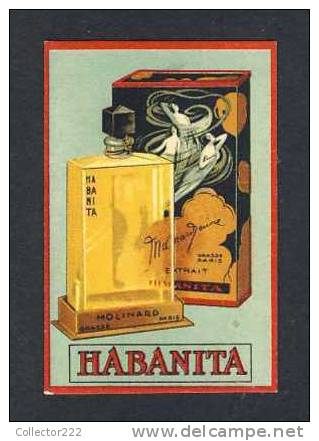

-----------------------------
Interested in Habanita?
Read here...
-----------------------------------------------








